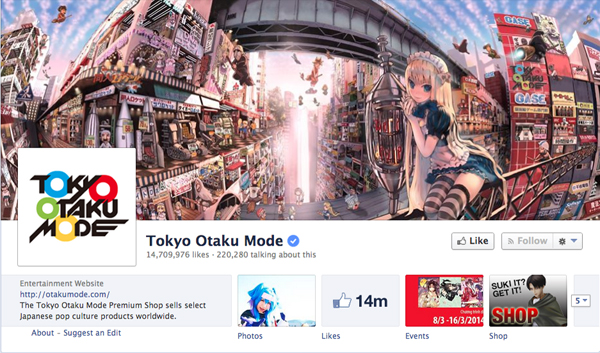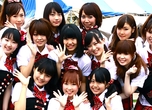From Akihabara to the world
How Tokyo Otaku Mode helped manga and anime become a global phenomenon

Tokyo Otaku Mode CEO Tomo Kamei
Posted: Thu Apr 10 2014
How many Japanese companies are better known abroad than in their home country? We struggle to come up with many examples, but Tokyo Otaku Mode certainly has to be one of them. Transmitting Japan’s ‘otaku’ culture to the world since 2011, this feisty newcomer has grown from one page on Facebook to a network of websites, mobile apps, and an entire marketplace selling every anime- and manga-related product imaginable. Time Out Tokyo caught up with two of the visionaries behind this success, CEO Tomo Kamei and co-founder Takuya Akiyama, and discussed the dramatic origins of the company, its mission, the international appeal of Japanese popular culture and much more.
How did Tokyo Otaku Mode get started? Could you give us a quick rundown of when and why it was founded?
Kamei: After graduating university and getting a job, I used to visit and study foreign companies to learn how they function. I was particularly interested in the potential for better internet services in developing countries, including Southeast Asia, and went over there to check out the situation. I’d ask the people running local sites about their role models, so to speak, and they’d mention Japanese or American services. I saw the potential for exporting popular Japanese web services and combining them with infrastructure improvement in e.g. Southeast Asia.
On the other hand, I’d go buy souvenirs on these trips, and Japanese content such as anime and manga was sold all over the place – obviously mostly pirated stuff. Creators and artists in Japan have been able to live on the size of the Japanese market, but with the population decreasing, they have to come up with a broader vision and actually make money on the global market. The manga and anime industries have already come far in this respect, so I wanted to create an ‘ecosystem’ of exchange that would improve the situation for everyone involved.
Of course, there are so many people in Japan talking about ‘going international’, but it’s easier said than done. The opening came through my previous job, where I was tasked with introducing Japan to Facebook – essentially getting companies to set up FB pages. This was 2010, when 500 million people were using FB internationally, but only three million users were signed up in Japan, so setting your sights on those 500 million was a pretty obvious choice.
I then came back to my idea about anime and manga, and decided on the medium of Facebook. I realised that we’d be able to spread the word about Japanese pop culture content to a massive audience through FB without spending a lot of money. We knew about the international demand for Japanese manga and anime, and as there’s always new stuff coming out wherever you look, it’s easy to come up with news and other stuff to tell users about. We finally launched the Facebook page in late March 2011.
So you kicked off right after the earthquake (3/11)?
Akiyama: Yeah, we were planning to launch the FB page on March 15, and were actually in the final stages when the earthquake struck.
Kamei: We obviously couldn’t launch the site as planned, so we postponed it by 10 days or so. I actually went to Fukushima on March 10 for work – I was originally supposed to go there the following day, but luckily there was a change of plans.
You didn’t consider postponing the project further, or putting it on ice?
Kamei: No, actually the opposite. We saw international media report stuff like ‘it’s over for Japan’, and rumours were flying around saying that this and this manga writer died. We wanted to tell people that Japan’s still alive and kicking.
Akiyama: We did debate whether it was appropriate to launch the site so soon after the disaster, but above all, we felt like we had to address the rumours that this and this manga or anime won’t be coming out any more because the creators are dead [laughs]. We wanted to tell people what was really going on, and in that way, reassure people, despite the fact that things were still pretty disorderly even here in Tokyo at that time.
Have you thought about what you’d like the company to achieve? Do you have a ‘mission’ in the back of your head somewhere?
Kamei: At first, due to the circumstances, we just wanted to help Japan recover. More broadly though, we want to take all the great content that’s produced in Japan and transmit it all over the world.
Akiyama: Manga, anime, and the entire ‘otaku culture’, including fashion, all these unique cultural products – we want to deliver them to people everywhere, not only to fans of Japanese anime and manga, but also to people who could become fans in the future. It’s not only through information either – we want to use e-commerce to let people know about aspects like figures, and thus help support Japanese industry and culture.
Your website focuses on user-created content, forming a sort of community for people interested in ‘otaku culture’. What are the main features of your website?
Kamei: We have the user-created galleries, news, info about our contributors, and e-commerce. We started with the FB site and then put up the galleries. First, we’d look for specific contributing artists, and then, having reached a sufficient scale, opened access and contributions to the public.
Akiyama: We have people contributing everything from drawings to cosplay pics, allowing people to present their work to a global audience. The FB site is mostly for the latest news, events and artist interviews. We also have a service where people can read samples of newly translated manga, just a couple of the first pages, and thus find new stuff to read. Our e-commerce site also carries products that feature work from our contributors – if you like something that’s been uploaded to our site, you can get that theme or image put on a T-shirt or an iPhone case. Finally, we have an app called Otaku Camera, which allows you to make your pictures look like something out of a manga, or add frames with your favourite characters. We’ve also had a Kyary Pamyu Pamyu feature in an app called Kawaii Camera, allowing you to take a pic ‘with her’.
Your FB page also has over 14 million likes…
Akiyama: Yeah, and around 99% of our fans are from abroad!
Kamei: One strange thing is that ever since back in the day, people often tell us that we must have a lot of people working for Tokyo Otaku Mode. Since that isn’t really the case, and especially wasn’t true a couple years ago, we were pretty confused. The reason was that when you search on FB, there are around 100 people claiming that they work for us. Our fans seem to have added those descriptions without us knowing [laughs].
We apparently have groups in Indonesia, the Philippines, France – groups we have no association with. We also have people contacting us about helping out with the business, and occasionally we even hire people as interns or regular employees that way.

We hear that the US is your biggest market.
Akiyama: Yes, especially in the beginning, American users predominated, but now we’re getting a lot of users from Asia as well. As for e-commerce, America is the biggest market, but Australians also like shopping with us.
How about Southeast Asia?
Akiyama: User amounts are going up in that region too, and anime events are also getting big, especially in places like Indonesia, Thailand and Singapore.
Kamei: People’s incomes are growing over there, and more people are watching anime as internet connections improve. Last year, Attack on Titan became huge, and judging from the cosplay stuff we’ve seen, people are pretty much watching it in real time. This show is so popular right now – it’s probably one of those phenomena that only come around once every 10 or 20 years. Especially when it was made into an anime, its popularity really shot through the roof. We always get a great response when uploading anything related to Attack on Titan.
Akiyama: There used to be a significant delay between when something became popular in Japan and when it became a hit internationally. Now, from around last year, that delay’s more or less gone, which is obviously due to improvements in internet connectivity worldwide.
Japanese anime and manga has become a huge phenomenon globally – what do you think it is about Japanese otaku culture that appeals internationally?
Kamei: I’m not really sure, but as you know, Japanese society and culture hasn’t really been to exposed to external influence to the degree that many other societies have been. A lot of Japanese content is very layered, deep, and touches on themes that aren’t really discussed in e.g. European or American comics or animation. Perhaps this originality does stem from our isolated position.
Akiyama: Abroad, the image that animation is something for children is still strong, and there aren’t many films or shows intended for a mature audience. In Japan, that age barrier doesn’t really exist, which might be why a lot of Japanese content appears very fresh to foreign audiences.
Yeah, the stereotype of anime being ‘childish’ still certainly exists, but it does seem to be retreating slowly.
Kamei: If you look at One Piece, the protagonist looks pretty weak compared to, say, Iron Man or The Hulk, so the basic viewpoint is really different. Nevertheless, we’ve noticed that the Japanese anime and manga that tend to attract attention are still ones that feature obviously ‘strong’ and typically Japanese characters.
What do you think about the Japanese government's efforts to promote domestic pop culture abroad?
Kamei: I think it’s great. We didn’t really pay attention to it at first, but when the ‘Cool Japan’ campaigns gathered steam, and now with the Olympics, we feel like those official efforts are complementary to what we’re doing. It might even be possible for us to cooperate with such efforts from here on.
Moving on, where would you like to take the company in the future? Any new developments you’d like to incorporate?
Kamei: Well, as of now, our earnings come from two sources: advertisement and e-commerce. We’re focusing on e-commerce now, and want to strengthen our position as the premier location to buy merchandise related to Japanese anime and manga. We’ve also realised the potential of our own brand, and are looking to cooperate with various partners to strengthen it further.
Do you have any plans to take the business more into the physical world, potentially in terms of events?
Kamei: Yeah, we’d like to hold an event this year. However, we also need to be careful not to over-expand, perhaps sacrificing quality in the process. In the last few years, we did participate in events in order to meet with our fans and users directly. For example, in San Francisco, we were surprised to notice that there were actually people who knew about Tokyo Otaku Mode – they even wanted to take pictures with me! The same happened in Singapore, actually meeting people who had learned about us online. I feel like our efforts are finally bearing fruit, and I’d like to keep spreading the word about our brand.
Last, what do you think will be next big otaku culture-related thing to come out of Japan?
Akiyama: It’s very difficult question. Recently I often heard that Japanese record companies are really coming on strong overall, and many of them want to promote their musicians and idol groups on the international entertainment market.
Kamei: Also, the band [One OK Rock] that made the music for Rurouni Kenshin (a popular samurai-themed manga series made into a live-action film in 2012) are very popular abroad, as well as in Japan. Going global right away gets you access to a huge market – the same is true for e-commerce, where certain items can suddenly explode in popularity, surprising Japanese producers that don’t really think about anything but the domestic market.
Tweets
- About Us |
- Work for Time Out |
- Send us info |
- Advertising |
- Mobile edition |
- Terms & Conditions |
- Privacy policy |
- Contact Us
Copyright © 2014 Time Out Tokyo














Add your comment